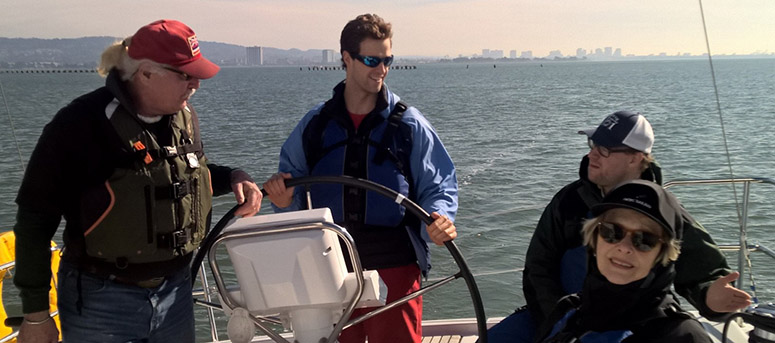There are those who say, "You can't sail on San Francisco Bay in the winter!' If by this they mean it's not blowing 20 knots, the Bay's famous short chop isn't causing spray to fly everywhere, and it's not overcast and cool -- well, then they might be right. However, this past week (the last in January), I had a lovely sailing experience that proves the naysayers quite wrong.

The winter months in San Francisco Bay can offer wonderful opportunities for sailing. Photo by Robert Farrar
By Captain Ray
Published: March, 2016
There are those who say, “You can’t sail on San Francisco Bay in the winter!” If by this they mean it’s not blowing 20 knots, the Bay’s famous short chop isn’t causing spray to fly everywhere, and it’s not overcast and cool -- well, then they might be right. However, this past week (the last in January), I had a lovely sailing experience that proves the naysayers quite wrong. At least in my opinion!
I was assigned to do a four hour skippered charter/lesson. This outing had originally been scheduled for the previous week. Because of a winter storm that brought much needed rain to the Bay Area, we rescheduled at the last minute. As it turned out, postponing was a great call, because the new day was warm and sunny. So we were already off to a good start. An added pleasure (and a surprise for both of us) was that the charterer was a student of mine from 20 years ago. He has been sailing ever since, including a passage from Rangiroa (in the Tuamotu Archipelago about 200 miles NNE of Tahiti) to Patagonia at the southern tip of South America, a distance of several thousand miles. He was now back in the Bay Area and wanted to share his passion with his nephew, who had never sailed.
As soon as we had cleared the Berkeley Marina breakwater, I directed the crew in raising the sails and then shut off the motor. Once the boat was sailing toward the Golden Gate, I turned the wheel over to the nephew. I stood alongside him answering his questions and providing the occasional bit of coaching.
It was definitely a light-air day. The wind never blew more than five or six knots, we were in shirt sleeves for the complete sail, there was no spray in our faces, no waves to challenge our balance and tire us out. We never saw a single whitecap on the Bay. However, other than motoring in and out of the Berkeley Marina, we sailed the entire time and our four hours together were extremely pleasant.
The nephew quickly got the hang of steering and was able to anticipate the boat’s movements and keep a steady course. He asked questions about how sails work and we began a discussion of airfoils, pressure differences and lift. I explained to him why boats cannot sail directly into the wind: When we try we enter what is commonly called ‘the no-go zone’, the sails merely become noisy flags (called luffing in sailor–speak). I had him turn the boat slowly into the no-go zone so he could see this happen and then turn back again until the luffing stopped. Now our course was as close to the wind as possible. The nephew understood the principles of physics that were involved and enjoyed the ‘science of it all’. Then something began to change: the wind. Or more precisely, the wind’s direction changed.
Wind is named for the direction from which it comes, and on that day it had been coming from the south. That had allowed us to sail directly toward the Golden Gate Bridge. Now it was veering (shifting clockwise from our perspective on the boat) and the sails were starting to luff.
I explained to the charterers our two options. We could make a small course alteration to starboard (the right) or we could make a big turn to port (the left) in order to get to the other side of the no-go zone. We opted for the latter plan (tacking in sailor-speak), which required moving the sails across the boat. Then we tacked several more times just for the practice.
As we began our downwind trip back home, we ate lunch and took photos to commemorate our fine day of sailing. All too soon our time together was over and we were back in the marina.
So please … don’t tell me you can’t sail on San Francisco Bay in the winter. I must beg to differ!
Ray Wichmann, is a US SAILING-certified Ocean Passagemaking Instructor, a US SAILING Master Instructor Trainer, and a member of US SAILING’s National Faculty. He holds a 100-Ton Master’s License, was a charter skipper in Hawai’i for 15 years, and has sailed on both coasts of the United States, in Mexico, the Caribbean and Greece. He is presently employed as the Master Instructor at OCSC Sailing in the Berkeley Marina.

